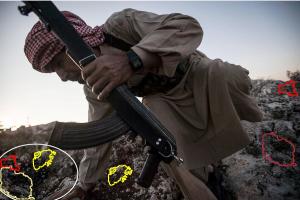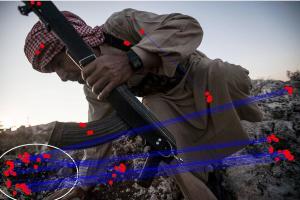In the picture, taken, Sept. 29, 2013, a Syrian opposition fighter takes cover during an exchange of fire with government forces in Telata village.
In many application scenarios digital images play a basic role and often it is important to assess if their content is realistic or has been manipulated to mislead watcher’s opinion. Image forensics tools provide answers to similar questions. We have been working on a novel method that focuses in particular on the problem of detecting if a tampered image has been created by cloning an area of the image onto another zone to make a duplication or to cancel something awkward.
The proposed approach is based on SIFT features and allows both to understand if a copy-move attack has occurred and which are the image points involved, and, furthermore, to recover which has been the geometric transformation happened to perform cloning, by computing the transformation parameters. In fact when a copy-move attack takes place, usually an affine transformation is applied to the image patch selected to fit in a specified position according to that context. Our experimental results confirm that the technique is able to precisely individuate the altered area and, in addition, to estimate the geometric transformation parameters with high reliability. The method also deals with multiple cloning.
On the basis of this technique developed to deal with tampered digital images a method for detecting copy-move forgery from printed pictures has been developed too. Experimental results demonstrated that forgeries detection is still successful though with reduced performances with respect to the digital case, as expected; the success of detection mainly depends on the printing quality and on the size of the printed pictures. Promising results have been obtained in the case of re-acquisition by a smartphone camera too.
Demo video: An Image Forensics Tool
Datasets:
MICC-F220: this dataset is composed by 220 images; 110 are tampered and 110 originals.
MICC-F2000: this dataset is composed by 2000 images; 700 are tampered and 1300 originals.
MICC-F8multi: 8 tampered images with realistic multiple cloning.
MICC-F600: this dataset is composed by 440 original images, 160 tampered images and 160 ground truth images
Software:
We release the MATLAB implementation of the copy-move detection approach presented in Amerini et al., IEEE-TIFS 2011.
- MICC-CMFD-1.0.zip – released May 8, 2012 (tested on Linux Ubuntu 10.04)
If you use these datasets or our software, please cite the paper: I. Amerini, L. Ballan, R. Caldelli, A. Del Bimbo, G. Serra. “A SIFT-based forensic method for copy-move attack detection and transformation recovery”, IEEE Transactions on Information Forensics and Security, vol. 6, issue 3, pp. 1099-1110, 2011.


